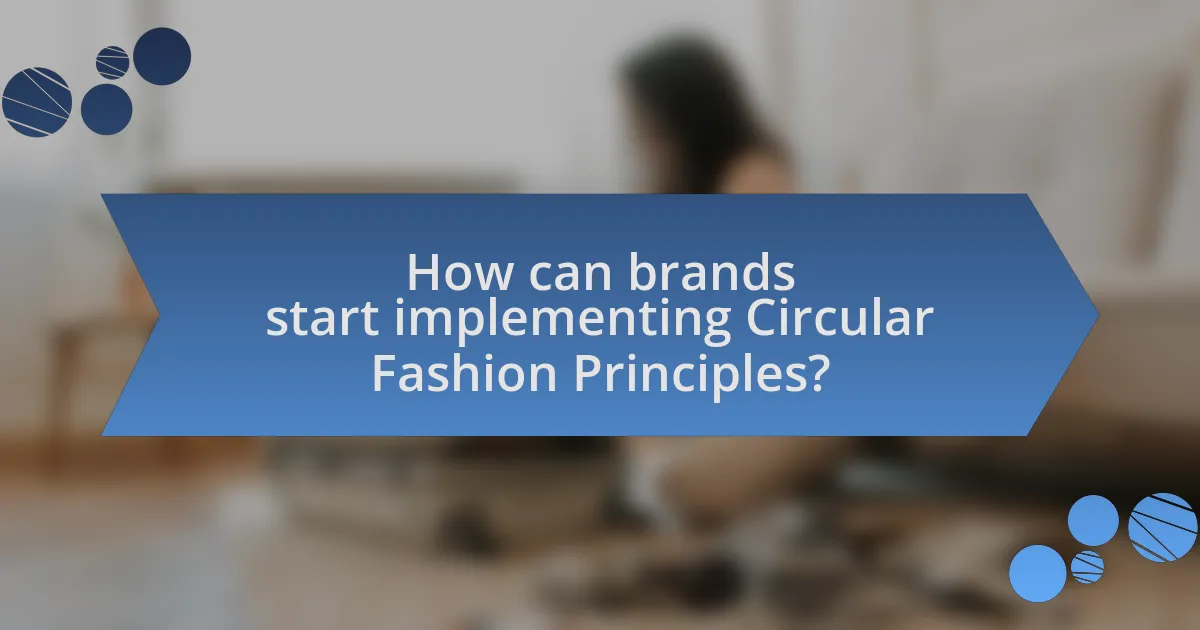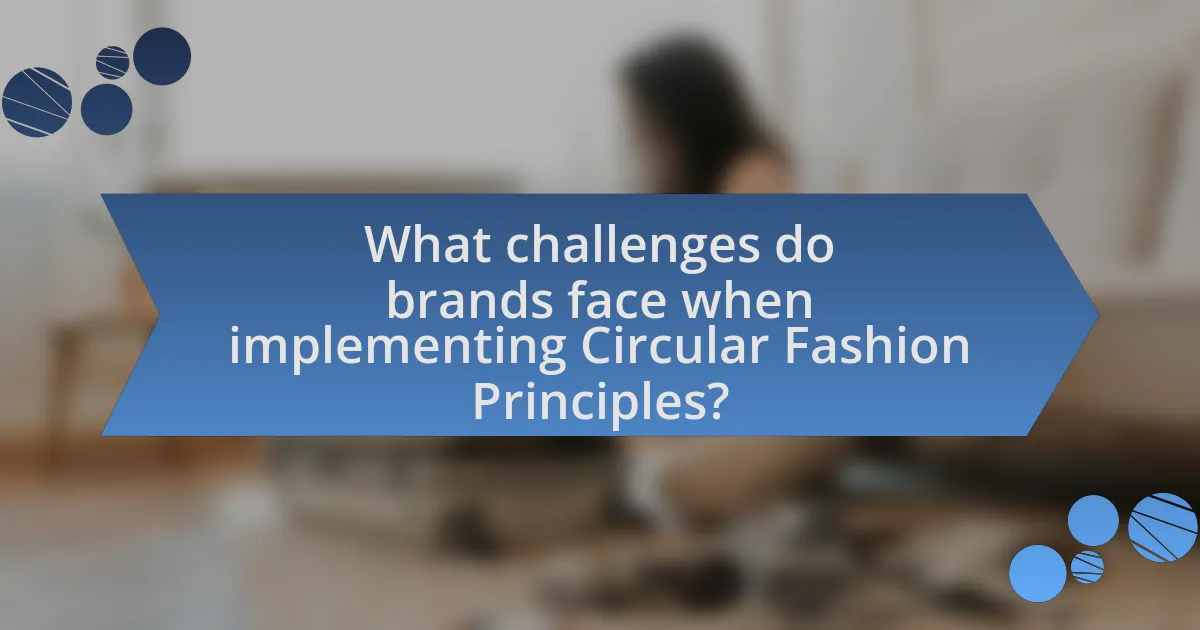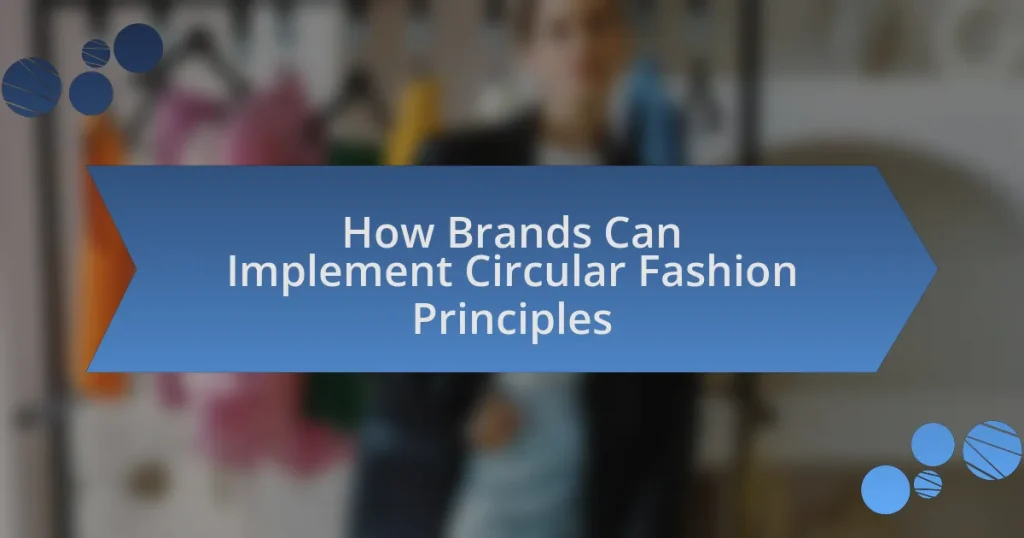The article focuses on how brands can implement Circular Fashion Principles to create a sustainable fashion industry. It outlines the key elements of circular fashion, including design for longevity, resource efficiency, waste reduction, and closed-loop systems. The article contrasts these principles with traditional linear fashion practices, emphasizing the environmental benefits of adopting circularity. It also discusses the economic advantages for brands, strategies for effective implementation, and the importance of stakeholder engagement. Additionally, it highlights the challenges brands may face during the transition and provides resources and best practices to facilitate the shift towards a more sustainable fashion model.

What are Circular Fashion Principles?
Circular fashion principles are guidelines aimed at creating a sustainable fashion industry by minimizing waste and maximizing resource efficiency. These principles include designing for longevity, promoting the use of renewable resources, encouraging recycling and upcycling, and fostering a closed-loop system where products are reused and materials are regenerated. For instance, the Ellen MacArthur Foundation emphasizes the importance of circularity in fashion, stating that transitioning to a circular economy can significantly reduce environmental impacts and resource consumption.
How do Circular Fashion Principles differ from traditional fashion practices?
Circular fashion principles prioritize sustainability and resource efficiency, contrasting sharply with traditional fashion practices that often emphasize linear production and consumption. In circular fashion, the focus is on designing products for longevity, reuse, and recyclability, which reduces waste and environmental impact. Traditional fashion typically follows a “take-make-dispose” model, leading to significant waste and resource depletion. For instance, the Ellen MacArthur Foundation reports that the fashion industry generates over 92 million tons of waste annually, highlighting the inefficiencies of traditional practices. In contrast, circular fashion aims to close the loop by keeping materials in use, thus promoting a more sustainable and responsible approach to fashion.
What are the key elements of Circular Fashion Principles?
The key elements of Circular Fashion Principles include design for longevity, resource efficiency, waste reduction, and closed-loop systems. Design for longevity emphasizes creating products that are durable and timeless, reducing the need for frequent replacements. Resource efficiency focuses on using sustainable materials and minimizing energy consumption during production. Waste reduction involves strategies to minimize textile waste throughout the supply chain, including recycling and upcycling. Closed-loop systems aim to create a cycle where products are returned to the production process at the end of their life, ensuring materials are reused and reducing environmental impact. These principles are supported by the Ellen MacArthur Foundation, which highlights the importance of transitioning to a circular economy in the fashion industry to mitigate environmental harm.
Why is sustainability important in the context of Circular Fashion?
Sustainability is crucial in the context of Circular Fashion because it minimizes waste and resource consumption while promoting the longevity of products. Circular Fashion aims to create a closed-loop system where materials are reused, recycled, or repurposed, significantly reducing the environmental impact of the fashion industry. According to the Ellen MacArthur Foundation, the fashion industry is responsible for 10% of global carbon emissions and is the second-largest consumer of the world’s water supply. By adopting sustainable practices, brands can help mitigate these effects, conserve resources, and foster a more responsible consumption model.
What are the benefits of implementing Circular Fashion Principles for brands?
Implementing Circular Fashion Principles offers brands several benefits, including enhanced sustainability, cost savings, and improved brand loyalty. By adopting these principles, brands can significantly reduce waste and resource consumption, leading to a lower environmental impact. For instance, a study by the Ellen MacArthur Foundation highlights that transitioning to a circular economy could generate $4.5 trillion in economic benefits by 2030, demonstrating the financial advantages of sustainable practices. Additionally, brands that prioritize circularity often experience increased customer loyalty, as consumers are increasingly drawn to environmentally responsible companies. This shift not only aligns with consumer values but also positions brands favorably in a competitive market focused on sustainability.
How can brands enhance their brand image through Circular Fashion?
Brands can enhance their brand image through Circular Fashion by adopting sustainable practices that prioritize resource efficiency and waste reduction. Implementing circular fashion principles, such as using recycled materials, designing for longevity, and promoting repair and resale options, demonstrates a commitment to environmental responsibility. This approach not only attracts eco-conscious consumers but also aligns with growing market trends; for instance, a 2021 McKinsey report indicated that 67% of consumers consider sustainability when making purchase decisions. By actively engaging in circular fashion, brands can differentiate themselves in a competitive market, build customer loyalty, and enhance their overall reputation.
What economic advantages do brands gain from adopting Circular Fashion Principles?
Brands gain significant economic advantages from adopting Circular Fashion Principles, including cost savings, increased customer loyalty, and new revenue streams. By implementing these principles, brands can reduce material costs through recycling and reusing resources, which lowers production expenses. For instance, a study by the Ellen MacArthur Foundation found that transitioning to a circular economy could generate $4.5 trillion in economic benefits by 2030. Additionally, brands that embrace sustainability often attract environmentally conscious consumers, leading to enhanced customer loyalty and potentially higher sales. Furthermore, circular practices can open up new business models, such as rental or resale services, which diversify revenue sources and create competitive advantages in the market.

How can brands start implementing Circular Fashion Principles?
Brands can start implementing Circular Fashion Principles by adopting strategies that prioritize sustainability, resource efficiency, and waste reduction. This includes designing products for longevity, utilizing recyclable or biodegradable materials, and establishing take-back programs to facilitate product recycling. For instance, brands like Patagonia have successfully integrated these principles by offering repair services and encouraging customers to return used items for recycling, thereby reducing landfill waste. Additionally, the Ellen MacArthur Foundation reports that transitioning to a circular economy in fashion could generate $560 billion in economic benefits, highlighting the financial viability of these practices.
What initial steps should brands take to transition to Circular Fashion?
Brands should begin their transition to Circular Fashion by conducting a comprehensive assessment of their current supply chain and product lifecycle. This initial step allows brands to identify areas where waste can be minimized and resources can be reused. For instance, a study by the Ellen MacArthur Foundation highlights that transitioning to a circular economy could generate $4.5 trillion in economic benefits by 2030, emphasizing the importance of resource efficiency. Following the assessment, brands should engage in designing products with longevity and recyclability in mind, ensuring that materials can be easily recovered and reused. Implementing take-back schemes and collaborating with recycling partners are also crucial steps to facilitate the circular process.
How can brands assess their current practices for sustainability?
Brands can assess their current practices for sustainability by conducting a comprehensive sustainability audit that evaluates their supply chain, resource usage, and waste management. This audit should include metrics such as carbon footprint, water usage, and material sourcing to identify areas for improvement. For instance, a study by McKinsey & Company found that companies that measure their sustainability performance can reduce costs by up to 20% while enhancing brand reputation. By utilizing frameworks like the Global Reporting Initiative (GRI) or the Sustainability Accounting Standards Board (SASB), brands can benchmark their practices against industry standards, ensuring they align with best practices in sustainability.
What role does stakeholder engagement play in this transition?
Stakeholder engagement is crucial in the transition to circular fashion principles as it fosters collaboration and shared responsibility among brands, consumers, suppliers, and policymakers. Engaging stakeholders ensures that diverse perspectives are considered, leading to more innovative solutions and effective implementation of sustainable practices. For instance, a study by the Ellen MacArthur Foundation highlights that brands that actively involve stakeholders in their circular initiatives are more likely to achieve significant reductions in waste and resource consumption. This collaborative approach not only enhances transparency but also builds trust, which is essential for driving systemic change in the fashion industry.
What strategies can brands adopt for effective implementation?
Brands can adopt several strategies for effective implementation of circular fashion principles, including designing for longevity, utilizing sustainable materials, and establishing take-back programs. Designing for longevity involves creating products that are durable and timeless, which reduces waste and encourages consumers to keep items longer. Utilizing sustainable materials, such as organic cotton or recycled polyester, minimizes environmental impact and supports resource conservation. Establishing take-back programs allows brands to reclaim used products, facilitating recycling and reducing landfill waste. These strategies are supported by research indicating that sustainable practices can enhance brand loyalty and consumer trust, ultimately leading to increased market share in the growing eco-conscious consumer segment.
How can brands incorporate sustainable materials into their supply chain?
Brands can incorporate sustainable materials into their supply chain by sourcing eco-friendly raw materials, such as organic cotton, recycled polyester, or biodegradable fabrics. This approach not only reduces environmental impact but also aligns with consumer demand for sustainable products. For instance, a report by McKinsey & Company highlights that the fashion industry could reduce greenhouse gas emissions by 1.1 billion tons annually by adopting sustainable materials. Additionally, brands can collaborate with suppliers who prioritize sustainability, ensuring that the entire supply chain adheres to eco-friendly practices. Implementing certifications like Global Organic Textile Standard (GOTS) or OEKO-TEX can further validate the sustainability of materials used.
What are the best practices for designing products with a circular approach?
The best practices for designing products with a circular approach include prioritizing sustainable materials, designing for longevity, and enabling easy disassembly for recycling. Sustainable materials, such as organic cotton or recycled plastics, reduce environmental impact and resource depletion. Designing for longevity involves creating durable products that withstand wear and tear, which can be supported by using high-quality components and timeless designs. Enabling easy disassembly allows for efficient recycling and repurposing of materials at the end of a product’s life cycle, facilitating a closed-loop system. These practices align with the principles of circular economy, which aim to minimize waste and maximize resource efficiency.

What challenges do brands face when implementing Circular Fashion Principles?
Brands face significant challenges when implementing Circular Fashion Principles, primarily due to the complexity of supply chain management. The transition to circularity requires brands to redesign products for longevity, recyclability, and resource efficiency, which often involves substantial changes in materials and processes. Additionally, brands encounter difficulties in sourcing sustainable materials that meet both environmental standards and consumer expectations.
Moreover, the lack of consumer awareness and demand for circular products can hinder adoption, as brands may struggle to justify the investment in circular practices without guaranteed market support. Financial constraints also pose a challenge, as the initial costs of transitioning to circular systems can be high, deterring brands from making necessary changes.
Lastly, regulatory hurdles and the need for collaboration across industries complicate the implementation of circular principles, as brands must navigate varying regulations and establish partnerships to create effective circular systems.
How can brands overcome common obstacles in the transition?
Brands can overcome common obstacles in the transition to circular fashion by adopting a comprehensive strategy that includes stakeholder engagement, investment in sustainable technologies, and education on circular principles. Engaging stakeholders, such as suppliers and consumers, fosters collaboration and ensures alignment on sustainability goals, which is crucial for successful implementation. Investment in sustainable technologies, such as recycling processes and eco-friendly materials, enables brands to create products that align with circular principles, reducing waste and resource consumption. Education on circular principles for both employees and consumers enhances understanding and commitment to sustainable practices, facilitating smoother transitions. Research indicates that companies that actively engage in stakeholder collaboration and invest in sustainable innovations see a 20% increase in operational efficiency and a significant reduction in environmental impact.
What are the financial implications of shifting to Circular Fashion?
Shifting to Circular Fashion can lead to significant financial implications, including cost savings, increased revenue opportunities, and enhanced brand loyalty. By adopting circular practices, brands can reduce material costs through recycling and reusing resources, which can lower production expenses by up to 30%, as reported by the Ellen MacArthur Foundation. Additionally, circular fashion opens new revenue streams through resale, rental, and refurbishment models, potentially increasing market share in the growing sustainable consumer segment, which is projected to reach $150 billion by 2025. Furthermore, brands that embrace sustainability often experience improved customer loyalty and brand reputation, translating into higher sales and customer retention rates.
How can brands address consumer perceptions and behaviors regarding sustainability?
Brands can address consumer perceptions and behaviors regarding sustainability by transparently communicating their sustainable practices and engaging consumers in the sustainability journey. For instance, brands can provide detailed information about their sourcing, production processes, and the environmental impact of their products. Research indicates that 66% of consumers are willing to pay more for sustainable brands, highlighting the importance of clear messaging and authenticity in sustainability efforts. Additionally, brands can involve consumers through initiatives like recycling programs or sustainability challenges, fostering a sense of community and shared responsibility. This approach not only enhances brand loyalty but also aligns with the growing consumer demand for ethical and sustainable practices in the fashion industry.
What resources are available to assist brands in this journey?
Brands can access various resources to assist in implementing circular fashion principles, including industry guidelines, sustainability frameworks, and collaborative platforms. The Ellen MacArthur Foundation provides comprehensive resources, such as the “Circular Economy 101” guide, which outlines key strategies for transitioning to circular practices. Additionally, organizations like the Sustainable Apparel Coalition offer tools like the Higg Index, which helps brands measure their environmental and social impacts. Furthermore, partnerships with NGOs and participation in initiatives like the Fashion Pact can enhance knowledge sharing and best practices among brands committed to sustainability.
What organizations provide support for brands adopting Circular Fashion Principles?
Organizations that provide support for brands adopting Circular Fashion Principles include the Ellen MacArthur Foundation, which focuses on promoting a circular economy through various initiatives and resources. Additionally, the Global Fashion Agenda offers tools and frameworks to help brands integrate sustainability into their operations. The Sustainable Apparel Coalition also supports brands by providing the Higg Index, a tool for measuring environmental and social sustainability. These organizations are instrumental in guiding brands towards implementing circular practices effectively.
How can brands leverage technology to facilitate circular practices?
Brands can leverage technology to facilitate circular practices by utilizing digital platforms for product tracking and lifecycle management. Technologies such as blockchain enable brands to trace materials from origin to end-of-life, ensuring transparency and accountability in sourcing and recycling processes. For instance, companies like Everledger use blockchain to track the provenance of diamonds, which can be adapted to textiles, allowing consumers to verify the sustainability of their purchases. Additionally, brands can implement AI-driven analytics to optimize resource use and reduce waste, as seen in the fashion industry where data analytics helps predict trends and manage inventory more efficiently. These technological applications not only enhance operational efficiency but also promote consumer engagement in circular practices by providing information on recycling and upcycling options.
What are the best practices for brands to ensure successful implementation of Circular Fashion Principles?
Brands can ensure successful implementation of Circular Fashion Principles by adopting a holistic approach that includes sustainable design, responsible sourcing, and consumer engagement. Sustainable design involves creating products that are durable, repairable, and recyclable, which reduces waste and extends the lifecycle of garments. Responsible sourcing requires brands to select materials that are renewable or recycled, minimizing environmental impact. Engaging consumers through education about the benefits of circular fashion encourages responsible consumption and promotes recycling initiatives. According to the Ellen MacArthur Foundation, transitioning to a circular economy in fashion could generate $560 billion in economic benefits by 2030, highlighting the financial viability of these practices.















